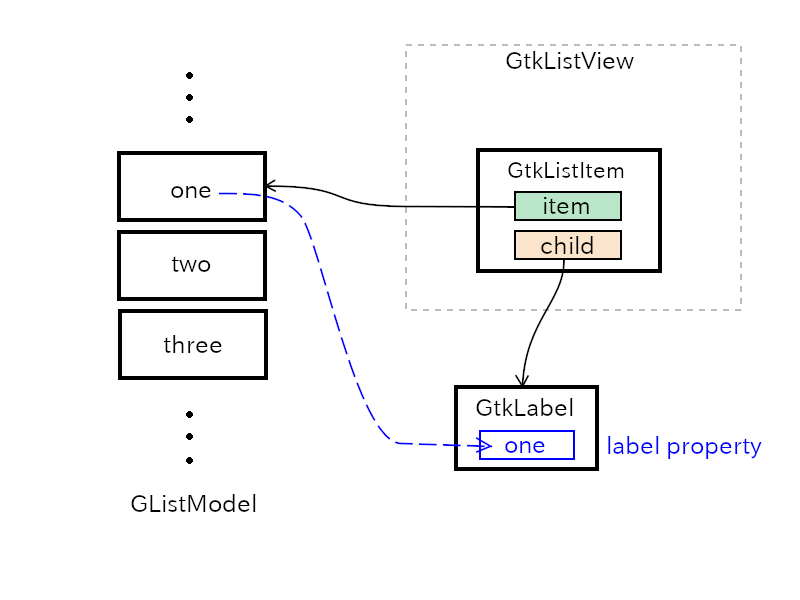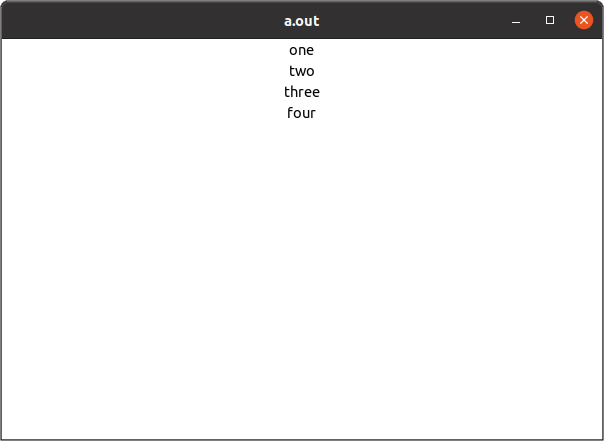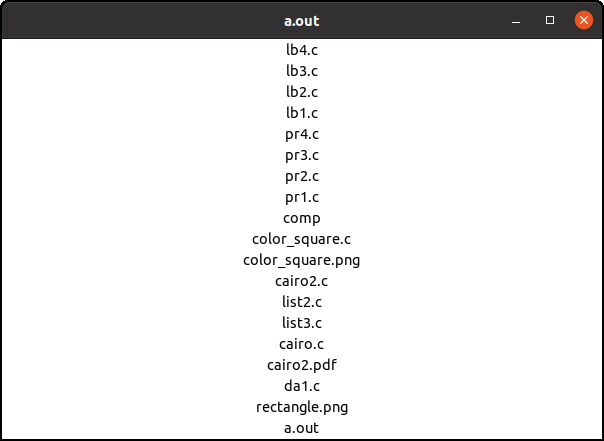19 KiB
Up: Readme.md, Prev: Section 23, Next: Section 25
GtkListView
Gtk4 has added new list objects GtkListView, GtkGridView and GtkColumnView. The new feature is described in the sections "GListModel support" and "List-based widgets" at the top of the third chapter of the API reference.
Gtk4 has other means to implement lists. They are GtkListBox and GtkTreeView which are took over from Gtk3. There's an article in Gtk Development blog about list widgets by Matthias Clasen. He described why GtkListView are developed to replace GtkListBox and GtkTreeView.
I want to explain GtkListView and its related objects in this tutorial.
Outline
A list is a sequential data structure. For example, an ordered string sequence "one", "two", "three", "four" is a list. Each element of the list is called item. A list is like an array, but in many cases it is implemented with pointers which point to the next item of the list. And it has a start point. So, each item can be referred by the index of the item (first item, second item, ..., nth item, ...). There are two cases. One is the index starts from one (one-based) and the other is it starts from zero (zero-based).
Gio provides GListModel interface. It is a zero-based list of the same type of GObject objects, or objects that implement the same interface. An object implements GListModel is usually not a widget. So, the list is not displayed on the screen directly. There's another object GtkListView which is a widget to display the list. The items in the list need to be connected to the items in GtkListView. GtkListItemFactory object maps items in the list to GListView.
The instruction to build the whole list related objects is:
- Implement the list object which implements GListModel.
- Build widgets and put GtkListView as a child of GtkScrolledWindow.
- Set GtkListItemFactory.
GListModel
If you want to make a list of strings with GListModel, for example, "one", "two", "three", "four", note that strings can't be items of the list. Because GListModel is a list of GObject objects and strings aren't GObject objects. So, you need a wrapper which is a gobject and contains a string. GtkStringObject is the wrapper object and GStringList, implements GListModel, is a list of GtkStringObject.
char *array[] = {"one", "two", "three", "four", NULL};
GtkStringList *stringlist = gtk_string_list_new ((const char * const *) array);
The function gtk_string_list_new creates GtkStringList object.
Its items are GtkStringObject objects which contain the strings "one", "two", "three" and "four".
There are functions to add items to the list or remove items from the list.
gtk_string_list_appendappends an item to the listgtk_string_list_removeremoves an item from the listgtk_string_list_get_stringgets a string in the list
See API document for the further information.
I'll explain the other list objects later.
GtkSelectionModel
GtkSelectionModel is an interface to support for selections. Thanks to this model, user can select items by clicking on them. It is implemented by GtkMultiSelection, GtkNoSelection and GtkSingleSelection objects. These three objects are usually enough to build an application. They are created with GListModel. You can also create them alone and add GListModel later.
- GtkMultiSelection supports multiple selection.
- GtkNoSelection supports no selection. This is a wrapper to GListModel when GtkSelectionModel is needed.
- GtkSingleSelection supports single selection.
GtkListView
GtkListView is a widget to show GListModel items. GtkListItem is used by GtkListView to represent items of a list model. But, GtkListItem itself is not a widget, so a user needs to set a widget, for example GtkLabel, as a child of GtkListView to display an item of the list model. "item" property of GtkListItem points an object that belongs to the list model.
In case the number of items is very big, for example more than a thousand, GtkListItem is recycled and connected to another item which is newly displayed. This recycle makes the number of GtkListItem objects fairly small, less than 200. This is very effective to restrain the growth of memory consumption so that GListModel can contain lots of items, for example, more than a million items.
GtkListItemFactory
GtkListItemFactory creates or recycles GtkListItem and connects it with an item of the list model. There are two child objects of this factory, GtkSignalListItemFactory and GtkBuilderListItemFactory.
GtkSignalListItemFactory
GtkSignalListItemFactory provides signals for users to configure a GtkListItem object. There are four signals.
- "setup" is emitted to set up GtkListItem object. A user sets its child widget in the handler. For example, creates a GtkLabel widget and sets the child property of GtkListItem object to it. This setting is kept even the GtkListItem object is recycled (to bind to another item of GModelList).
- "bind" is emitted to bind an item in the list model to the widget. For example, a user gets the item object from "item" property of the GtkListItem object. Then gets the string of the item and sets the label property of the GtkLabel object with the string. This signal is emitted when the GtkListItem is newly created and set up, recycled or some changes has happened to the item of the list.
- "unbind" is emitted to unbind an item. A user undoes everything done in step 2 in the signal handler. If some object are created in step 2, they must be destroyed.
- "teardown" is emitted to undo everything done in step 1. So, the widget created in step 1 must be destroyed. After this signal, the list item will be destroyed.
The following program list1.c shows the list of strings "one", "two", "three" and "four".
GtkNoSelection is used, so user can't select any item.
1 #include <gtk/gtk.h>
2
3 static void
4 setup_cb (GtkListItemFactory *factory, GtkListItem *listitem, gpointer user_data) {
5 GtkWidget *lb = gtk_label_new ("");
6 gtk_list_item_set_child (listitem, lb);
7 }
8
9 static void
10 bind_cb (GtkSignalListItemFactory *self, GtkListItem *listitem, gpointer user_data) {
11 GtkWidget *lb = gtk_list_item_get_child (listitem);
12 GtkStringObject *strobj = gtk_list_item_get_item (listitem);
13 const char *text = gtk_string_object_get_string (strobj);
14
15 gtk_label_set_text (GTK_LABEL (lb), text);
16 }
17
18 static void
19 unbind_cb (GtkSignalListItemFactory *self, GtkListItem *listitem, gpointer user_data) {
20 GtkWidget *lb = gtk_list_item_get_child (listitem);
21 gtk_label_set_text (GTK_LABEL (lb), "");
22 }
23
24 static void
25 teardown_cb (GtkListItemFactory *factory, GtkListItem *listitem, gpointer user_data) {
26 gtk_list_item_set_child (listitem, NULL);
27 /* When the child of listitem is set to NULL, the reference to GtkLabel will be released and lb will be destroyed. */
28 /* Therefore, g_object_unref () for the GtkLabel object doesn't need in the user code. */
29 }
30
31 /* ----- activate, open, startup handlers ----- */
32 static void
33 app_activate (GApplication *application) {
34 GtkApplication *app = GTK_APPLICATION (application);
35 GtkWidget *win = gtk_application_window_new (app);
36 gtk_window_set_default_size (GTK_WINDOW (win), 600, 400);
37 GtkWidget *scr = gtk_scrolled_window_new ();
38 gtk_window_set_child (GTK_WINDOW (win), scr);
39
40 char *array[] = {
41 "one", "two", "three", "four", NULL
42 };
43 GtkStringList *sl = gtk_string_list_new ((const char * const *) array);
44 GtkNoSelection *ns = gtk_no_selection_new (G_LIST_MODEL (sl));
45
46 GtkListItemFactory *factory = gtk_signal_list_item_factory_new ();
47 g_signal_connect (factory, "setup", G_CALLBACK (setup_cb), NULL);
48 g_signal_connect (factory, "bind", G_CALLBACK (bind_cb), NULL);
49 g_signal_connect (factory, "unbind", G_CALLBACK (unbind_cb), NULL);
50 g_signal_connect (factory, "teardown", G_CALLBACK (teardown_cb), NULL);
51
52 GtkWidget *lv = gtk_list_view_new (GTK_SELECTION_MODEL (ns), factory);
53 gtk_scrolled_window_set_child (GTK_SCROLLED_WINDOW (scr), lv);
54 gtk_widget_show (win);
55 }
56
57 static void
58 app_startup (GApplication *application) {
59 }
60
61 /* ----- main ----- */
62 int
63 main (int argc, char **argv) {
64 GtkApplication *app;
65 int stat;
66
67 app = gtk_application_new ("com.github.ToshioCP.list1", G_APPLICATION_FLAGS_NONE);
68
69 g_signal_connect (app, "startup", G_CALLBACK (app_startup), NULL);
70 g_signal_connect (app, "activate", G_CALLBACK (app_activate), NULL);
71
72 stat =g_application_run (G_APPLICATION (app), argc, argv);
73 g_object_unref (app);
74 return stat;
75 }
76
The file list1.c is located under the directory src/misc.
Make a shell script below and save it to $HOME/local/bin/comp (comp is the filename).
gcc `pkg-config --cflags gtk4` $1.c `pkg-config --libs gtk4`
Change the current directory to the directory includes list1.c and type as follows.
$ chmod 755 $HOME/local/bin/comp
$ comp list1
$ ./a.out
Then, list1.c has been compiled and executed.
I think the program is not so difficult. If you feel some difficulty, read this section again, especially GtkSignalListItemFactory subsubsection.
GtkBuilderListItemFactory
GtkBuilderListItemFactory is another GtkListItemFactory. Its behavior is defined with ui file.
<interface>
<template class="GtkListItem">
<property name="child">
<object class="GtkLabel">
<binding name="label">
<lookup name="string" type="GtkStringObject">
<lookup name="item">GtkListItem</lookup>
</lookup>
</binding>
</object>
</property>
</template>
</interface>
Template tag is used to define GtkListItem. And its child property is GtkLabel object. The factory sees this template and creates GtkLabel and sets the child property of GtkListItem. This is the same as what setup handler of GtkSignalListItemFactory did.
Then, bind the label property of GtkLabel to string property of GtkStringObject. The string object is referred to by item property of GtkListItem. So, the lookup tag is like this:
string <- GtkStringObject <- item <- GtkListItem
The source code is as follows.
Its name is list2.c and located under src/misc directory.
1 #include <gtk/gtk.h>
2
3 /* ----- activate, open, startup handlers ----- */
4 static void
5 app_activate (GApplication *application) {
6 GtkApplication *app = GTK_APPLICATION (application);
7 GtkWidget *win = gtk_application_window_new (app);
8 gtk_window_set_default_size (GTK_WINDOW (win), 600, 400);
9 GtkWidget *scr = gtk_scrolled_window_new ();
10 gtk_window_set_child (GTK_WINDOW (win), scr);
11
12 char *array[] = {
13 "one", "two", "three", "four", NULL
14 };
15 GtkStringList *sl = gtk_string_list_new ((const char * const *) array);
16 GtkSingleSelection *ss = gtk_single_selection_new (G_LIST_MODEL (sl));
17
18 const char *ui_string =
19 "<interface>"
20 "<template class=\"GtkListItem\">"
21 "<property name=\"child\">"
22 "<object class=\"GtkLabel\">"
23 "<binding name=\"label\">"
24 "<lookup name=\"string\" type=\"GtkStringObject\">"
25 "<lookup name=\"item\">GtkListItem</lookup>"
26 "</lookup>"
27 "</binding>"
28 "</object>"
29 "</property>"
30 "</template>"
31 "</interface>"
32 ;
33 GBytes *gbytes = g_bytes_new_static (ui_string, strlen (ui_string));
34 GtkListItemFactory *factory = gtk_builder_list_item_factory_new_from_bytes (NULL, gbytes);
35
36 GtkWidget *lv = gtk_list_view_new (GTK_SELECTION_MODEL (ss), factory);
37 gtk_scrolled_window_set_child (GTK_SCROLLED_WINDOW (scr), lv);
38 gtk_widget_show (win);
39 }
40
41 static void
42 app_startup (GApplication *application) {
43 }
44
45 /* ----- main ----- */
46 int
47 main (int argc, char **argv) {
48 GtkApplication *app;
49 int stat;
50
51 app = gtk_application_new ("com.github.ToshioCP.list2", G_APPLICATION_FLAGS_NONE);
52
53 g_signal_connect (app, "startup", G_CALLBACK (app_startup), NULL);
54 g_signal_connect (app, "activate", G_CALLBACK (app_activate), NULL);
55
56 stat =g_application_run (G_APPLICATION (app), argc, argv);
57 g_object_unref (app);
58 return stat;
59 }
60
No signal handler is needed for GtkBulderListItemFactory. GtkSingleSelection is used, so user can select one item at a time.
Because this is a small program, the ui data is given as strings. However, generally, ui file is better than string and using resource compiler is the best choice.
GtkDirectoryList
GtkDirectoryList is a list model containing GFileInfo objects which are information of files under a certain directory.
It uses g_file_enumerate_children_async() to get the GFileInfo objects.
The list model is created by gtk_directory_list_new function.
GtkDirectoryList *gtk_directory_list_new (const char *attributes, GFile *file);
attributes is a comma separated list of file attributes.
File attributes are key-value pairs.
A key consists of a namespace and a name.
For example, "standard::name" key is the name of a file.
"standard" means general file information.
"name" means filename.
The following table shows some example.
| key | meaning |
|---|---|
| standard::type | file type. for example, regular file, directory, symbolic link, etc. |
| standard::name | filename |
| standard::size | file size in bytes |
| access::can-read | read privilege if the user is able to read the file |
| time::modified | the time the file was last modified in seconds since the UNIX epoch |
The current directory is ".".
The following program makes GtkDirectoryList dl and its contents are GFileInfo objects under the current directory.
GFile *file = g_file_new_for_path (".");
GtkDirectoryList *dl = gtk_directory_list_new ("standard::name", file);
g_object_unref (file);
It is not so difficult to make file listing program by changing list2.c in the previous subsection.
One problem is that GInfoFile doesn't have properties.
Lookup tag look for a property, so it is useless for looking for a filename from a GFileInfo object.
Instead, closure tag is appropriate in this case.
Closure tag specifies a function and the type of the return value of the function.
char *
get_file_name (GtkListItem *item, GFileInfo *info) {
if (! G_IS_FILE_INFO (info))
return NULL;
else
return g_strdup (g_file_info_get_name (info));
}
... ...
... ...
"<interface>"
"<template class=\"GtkListItem\">"
"<property name=\"child\">"
"<object class=\"GtkLabel\">"
"<binding name=\"label\">"
"<closure type=\"gchararray\" function=\"get_file_name\">"
"<lookup name=\"item\">GtkListItem</lookup>"
"</closure>"
"</binding>"
"</object>"
"</property>"
"</template>"
"</interface>"
- "gchararray" is the type of strings. "gchar" is the same as "char" type. Therefore, "gchararray" is "an array of char type", which is the same as string type. It is used to get the type of GValue object. GValue is a generic value and it can contain various type of values. For example, the type can be gboolean, gchar (char), gint (int), gfloat (float), gdouble (double), gchararray (char *) and so on. For the further information, refer to GFileAttribute and GFileInfo section in GIO API reference.
- closure tag has type attribute and function attribute.
Function attribute specifies a function name and type attribute specifies the type of the return value of the function.
The contents of closure tag (it is between <closure...> and</closure>) is parameters of the function.
<lookup name=\"item\">GtkListItem</lookup>gives two parameters. The first parameter is GListItem object and the second parameter is item property, which is a GFileInfo object in the GtkDirectoryList Object. gtk_file_namefunction first check theinfoparameter. Because it can be NULL when GListItemitemis unbound. If its GFileInfo, then return the filename (copy of the filename).
The whole program (list3.c) is as follows.
The program is located in src/misc directory.
1 #include <gtk/gtk.h>
2
3 char *
4 get_file_name (GtkListItem *item, GFileInfo *info) {
5 if (! G_IS_FILE_INFO (info))
6 return NULL;
7 else
8 return g_strdup (g_file_info_get_name (info));
9 }
10
11 /* ----- activate, open, startup handlers ----- */
12 static void
13 app_activate (GApplication *application) {
14 GtkApplication *app = GTK_APPLICATION (application);
15 GtkWidget *win = gtk_application_window_new (app);
16 gtk_window_set_default_size (GTK_WINDOW (win), 600, 400);
17 GtkWidget *scr = gtk_scrolled_window_new ();
18 gtk_window_set_child (GTK_WINDOW (win), scr);
19
20 GFile *file = g_file_new_for_path (".");
21 GtkDirectoryList *dl = gtk_directory_list_new ("standard::name", file);
22 g_object_unref (file);
23 GtkNoSelection *ns = gtk_no_selection_new (G_LIST_MODEL (dl));
24
25 const char *ui_string =
26 "<interface>"
27 "<template class=\"GtkListItem\">"
28 "<property name=\"child\">"
29 "<object class=\"GtkLabel\">"
30 "<binding name=\"label\">"
31 "<closure type=\"gchararray\" function=\"get_file_name\">"
32 "<lookup name=\"item\">GtkListItem</lookup>"
33 "</closure>"
34 "</binding>"
35 "</object>"
36 "</property>"
37 "</template>"
38 "</interface>"
39 ;
40 GBytes *gbytes = g_bytes_new_static (ui_string, strlen (ui_string));
41 GtkListItemFactory *factory = gtk_builder_list_item_factory_new_from_bytes (NULL, gbytes);
42
43 GtkWidget *lv = gtk_list_view_new (GTK_SELECTION_MODEL (ns), factory);
44 gtk_scrolled_window_set_child (GTK_SCROLLED_WINDOW (scr), lv);
45 gtk_widget_show (win);
46 }
47
48 static void
49 app_startup (GApplication *application) {
50 }
51
52 /* ----- main ----- */
53 int
54 main (int argc, char **argv) {
55 GtkApplication *app;
56 int stat;
57
58 app = gtk_application_new ("com.github.ToshioCP.list3", G_APPLICATION_FLAGS_NONE);
59
60 g_signal_connect (app, "startup", G_CALLBACK (app_startup), NULL);
61 g_signal_connect (app, "activate", G_CALLBACK (app_activate), NULL);
62
63 stat =g_application_run (G_APPLICATION (app), argc, argv);
64 g_object_unref (app);
65 return stat;
66 }
67
Compile and execute it.
$ cd misc
$ comp list3
$ ./a.out
Up: Readme.md, Prev: Section 23, Next: Section 25



